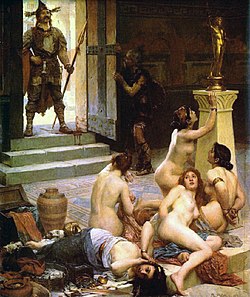Battle of the Allia
| Battle of the Allia | |||||||
|---|---|---|---|---|---|---|---|
| Part of Roman-Gallic Wars | |||||||
 Paul Jamin, Brennus and His Share of the Spoils, 1893 |
|||||||
|
|||||||
| Belligerents | |||||||
| Roman Republic | Senone Gauls | ||||||
| Commanders and leaders | |||||||
| The military tribunes with consular powers. There were 6 such tribunes. The sources did not say how many fought in the battle. | Brennus | ||||||
| Strength | |||||||
| The estimates are: 15,000, 24,000, 35.000, and 40,000 | The estimates are: 12,000, more than 40,000. and 30-70,000 | ||||||
| Casualties and losses | |||||||
| Unknown | Unknown | ||||||
The Battle of the Allia was fought between the Senones (one of the Gallic tribes which had invaded northern Italy) and the Romans. It was fought at the confluence of the rivers Tiber and Allia, eleven Roman miles north of Rome. The Romans were routed and subsequently the Senones sacked Rome. The common date given for the battle is 390 BC. This is based on the account of the battle by the Roman historian Livy and the Varronian Chronology, a Roman dating system. Following the ancient Greek historian Polybius, who used a Greek dating system, instead, yields 387/6 BC. Plutarch wrote that the battle took place just after the summer solstice when the moon was near the full, a little more than three hundred and sixty years from the foundation of Rome. That would be shortly after 393 BC. Tacitus said that the battle took place the 15 before the Kalends of August, which is 18 July.
The Senones were one of the various Gallic tribes which had recently invaded northern Italy. They settled on the Adriatic coast around where modern Rimini is. According to Livy, they were called to the Etruscan town of Clusium (modern Chiusi in Tuscany) by Aruns, an influential young man of the city who wanted to take revenge against Lucumo, who had "debauched his wife." When the Senones appeared, the Clusians felt threatened and asked Rome for help. The Romans sent the three sons of Marcus Fabius Ambustus, one of Rome’s most powerful aristocrats, as ambassadors. They told the Gauls not to attack Clusium and that if they did, the Romans would fight to defend the town. They then asked to negotiate a peace. The Senones accepted a peace on condition that the Clusians would give them some land. There was a quarrel and a battle broke out. The Roman ambassadors joined in. One of them killed a Senone chieftain. This was a violation of the rule that ambassadors have to be neutral. The brothers had taken sides and moreover, one of them had killed a Senone. The Gauls withdrew to discuss what action to take.
...
Wikipedia
